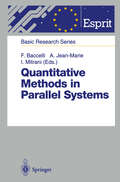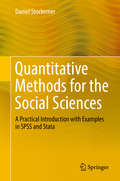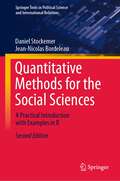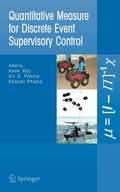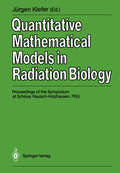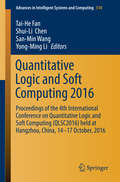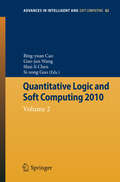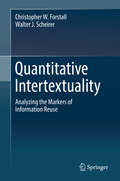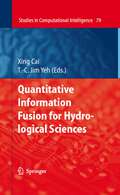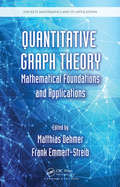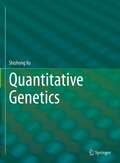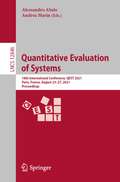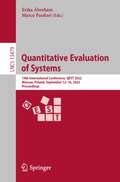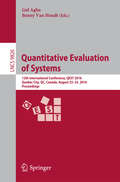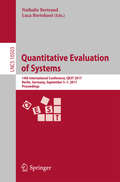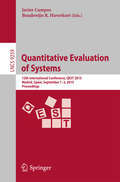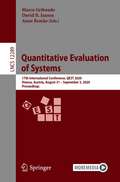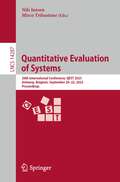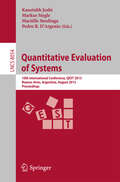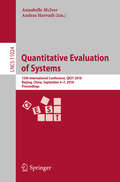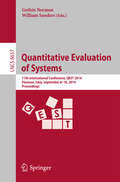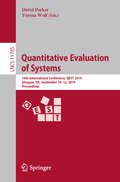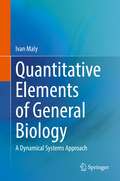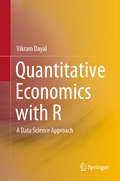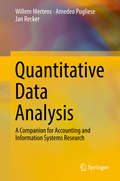- Table View
- List View
Quantitative Methods in Parallel Systems (ESPRIT Basic Research Series)
by Francois Baccelli Alain Jean-Marie Isi MitraniIt is widely recognized that the complexity of parallel and distributed systems is such that proper tools must be employed during their design stage in order to achieve the quantitative goals for which they are intended. This volume collects recent research results obtained within the Basic Research Action Qmips, which bears on the quantitative analysis of parallel and distributed architectures. Part 1 is devoted to research on the usage of general formalisms stemming from theoretical computer science in quantitative performance modeling of parallel systems. It contains research papers on process algebras, on Petri nets, and on queueing networks. The contributions in Part 2 are concerned with solution techniques. This part is expected to allow the reader to identify among the general formalisms of Part I, those that are amenable to an efficient mathematical treatment in the perspective of quantitative information. The common theme of Part 3 is the application of the analytical results of Part 2 to the performance evaluation and optimization of parallel and distributed systems. Part 1. Stochastic Process Algebras are used by N. Gotz, H. Hermanns, U. Herzog, V. Mertsiotakis and M. Rettelbach as a novel approach for the struc tured design and analysis of both the functional behaviour and performability (i.e performance and dependability) characteristics of parallel and distributed systems. This is achieved by integrating stochastic modeling and analysis into the powerful and well investigated formal description techniques of process algebras.
Quantitative Methods for the Social Sciences: A Practical Introduction With Examples In Spss And Stata
by Daniel StockemerThis textbook offers an essential introduction to survey research and quantitative methods. Building on the premise that statistical methods need to be learned in a practical fashion, the book guides students through the various steps of the survey research process and helps to apply those steps toward a real example. In detail, the textbook introduces students to the four pillars of survey research and quantitative analysis: (1) the importance of survey research, (2) preparing a survey, (3) conducting a survey and (4) analyzing a survey. Students are shown how to create their own questionnaire based on some theoretically derived hypotheses to achieve empirical findings for a solid dataset. Lastly, they use said data to test their hypotheses in a bivariate and multivariate realm. The book explains the theory, rationale and mathematical foundations of these tests. In addition, it provides clear instructions on how to conduct the tests in SPSS and Stata. Given the breadth of its coverage, the textbook is suitable for introductory statistics, survey research or quantitative methods classes in the social sciences.
Quantitative Methods for the Social Sciences: A Practical Introduction with Examples in R (Springer Texts in Political Science and International Relations)
by Daniel Stockemer Jean-Nicolas BordeleauThis textbook offers an essential introduction to survey research and quantitative methods with clear instructions on how to conduct statistical tests with R. Building on the premise that we need to teach statistical methods in a holistic and practical format, the book guides students through the four main elements of survey research and quantitative analysis: (1) the importance of survey research, (2) preparing a survey, (3) conducting a survey and (4) analyzing a survey. In detail, students will learn how to create their own questionnaire on the basis of formulating hypotheses; sampling participants; disseminating their questionnaire; creating datasets; and analyzing their data. The data analytical sections of this revised and extended edition explain the theory, rationale and mathematical foundations of relevant bivariate and multi-variate statistical tests. These include the T-test, F-test, Chi-square test and correlation analyses, as well as bivariate and multivariate regression analyses. In addition, the book offers a brief introduction to statistical computing with R, which includes clear instructions on how to conduct these statistical tests in R. Given the breadth of its coverage, the textbook is suitable for introductory statistics, survey research and quantitative methods classes in the social sciences.
Quantitative Measure for Discrete Event Supervisory Control
by Asok Ray Vir V. Phoha Shashi PhohaSupervisory Control Theory (SCT) provides a tool to model and control human-engineered complex systems, such as computer networks, World Wide Web, identification and spread of malicious executables, and command, control, communication, and information systems. Although there are some excellent monographs and books on SCT to control and diagnose discrete-event systems, there is a need for a research monograph that provides a coherent quantitative treatment of SCT theory for decision and control of complex systems. This new monograph will assimilate many new concepts that have been recently reported or are in the process of being reported in open literature. The major objectives here are to present a) a quantitative approach, supported by a formal theory, for discrete-event decision and control of human-engineered complex systems; and b) a set of applications to emerging technological areas such as control of software systems, malicious executables, and complex engineering systems. The monograph will provide the necessary background materials in automata theory and languages for supervisory control. It will introduce a new paradigm of language measure to quantitatively compare the performance of different automata models of a physical system. A novel feature of this approach is to generate discrete-event robust optimal decision and control algorithms for both military and commercial systems.
Quantitative Mathematical Models in Radiation Biology: Proceedings of the Symposium at Schloss Rauisch-Holzhausen, FRG, July 1987
by Jürgen KieferRadiation is the one agent among all environmental factors which may damage biological systems that is not only easily quantifiable but can also be measured with unsurpassed resolution. Its primary effects on atoms and molecules are well understood, and the secondary processes can be followed by sophisticated experimental techniques. The quantum nature of interactions and the importance of stochastic variations call for an exact mathematical description. This task is by no means simple, and presents a challenge both to the experimentalist and to the theoretician. It is hoped that a generally acceptable formalism will help to quantify radiation responses, both in radiation protection and radiation therapy, and make it possible to move from a purely empirical approach with all its fallacies to real understanding.
Quantitative Logic and Soft Computing 2016: Proceedings of the 4th International Conference on Quantitative Logic and Soft Computing (QLSC2016) held at Hangzhou, China, 14-17 October, 2016 (Advances in Intelligent Systems and Computing #510)
by Tai-He Fan Shui-Li Chen San-Min Wang Yong-Ming LiThis book is the proceedings of the Fourth International Conference on Quantitative Logic and Soft Computing (QLSC2016) held 14-17, October, 2016 in Zhejiang Sci-Tech University, Hangzhou, China. It includes 61 papers, of which 5 are plenary talks( 3 abstracts and 2 full length talks). QLSC2016 was the fourth in a series of conferences on Quantitative Logic and Soft Computing. This conference was a major symposium for scientists, engineers and practitioners to present their updated results, ideas, developments and applications in all areas of quantitative logic and soft computing. The book aims to strengthen relations between industry research laboratories and universities in fields such as quantitative logic and soft computing worldwide as follows: (1) Quantitative Logic and Uncertainty Logic; (2) Automata and Quantification of Software; (3) Fuzzy Connectives and Fuzzy Reasoning; (4) Fuzzy Logical Algebras; (5) Artificial Intelligence and Soft Computing; (6) Fuzzy Sets Theory and Applications.
Quantitative Logic and Soft Computing: Vol 2 (Advances in Intelligent and Soft Computing #82)
by Bing-Yuan Cao Shuili Chen Guojun Wang Sicong GuoAdmittedly, the notion “intelligence or intelligent computing” has been around us for several decades, implicitly indicating any non-conventional methods of solving complex system problems such as expert systems and intelligent control techniques that mimic human skill and replace human operators for automation. Various kinds of intelligent methods have been suggested, phenomenological or ontological, and we have been witnessing quite successful applications. On the other hand, “Soft Computing Techniques” is the concept coined by Lot? Zadeh, referring to “a set of approaches of computing which parallels the remarkable ability of the human mind to reason and learn in an environment of uncertainty, imprecision and partial truth. ” Such a notion is well contrasted with the conventionalbinary logic based hard c- puting and has been effectively utilized with the guiding principle of “exploiting the tolerance for uncertainty,imprecision and partial truth to achieve tractability, - bustness and low solution cost. ” The soft computing techniques are often employed as the technical entities in a tool box with tools being FL, ANN, Rough Set, GA etc. Based on one’s intuition and experience, an engineer can build and realize hum- like systems by smartly mixing proper technical tools effectivelyand ef?ciently in a wide range of ?elds. For some time, the soft computing techniques are also referred to as intelligent computing tools.
Quantitative Intertextuality: Analyzing the Markers of Information Reuse
by Christopher W. Forstall Walter J. ScheirerThis book introduces quantitative intertextuality, a new approach to the algorithmic study of information reuse in text, sound and images. Employing a variety of tools from machine learning, natural language processing, and computer vision, readers will learn to trace patterns of reuse across diverse sources for scholarly work and practical applications.The respective chapters share highly novel methodological insights in order to guide the reader through the basics of intertextuality. In Part 1, “Theory”, the theoretical aspects of intertextuality are introduced, leading to a discussion of how they can be embodied by quantitative methods. In Part 2, “Practice”, specific quantitative methods are described to establish a set of automated procedures for the practice of quantitative intertextuality. Each chapter in Part 2 begins with a general introduction to a major concept (e.g., lexical matching, sound matching, semantic matching), followed by a case study (e.g., detecting allusions to a popular television show in tweets, quantifying sound reuse in Romantic poetry, identifying influences in fan faction by thematic matching), and finally the development of an algorithm that can be used to reveal parallels in the relevant contexts.Because this book is intended as a “gentle” introduction, the emphasis is often on simple yet effective algorithms for a given matching task. A set of exercises is included at the end of each chapter, giving readers the chance to explore more cutting-edge solutions and novel aspects to the material at hand. Additionally, the book’s companion website includes software (R and C++ library code) and all of the source data for the examples in the book, as well as supplemental content (slides, high-resolution images, additional results) that may prove helpful for exploring the different facets of quantitative intertextuality that are presented in each chapter.Given its interdisciplinary nature, the book will appeal to a broad audience. From practitioners specializing in forensics to students of cultural studies, readers with diverse backgrounds (e.g., in the social sciences, natural language processing, or computer vision) will find valuable insights.
Quantitative Information Fusion for Hydrological Sciences (Studies in Computational Intelligence #79)
by Xing Cai T. C. Jim YehIn this rapidly evolving world of knowledge and technology, do you ever wonder how hydrology is catching up? Here, two highly qualified scientists edit a volume that takes the angle of computational hydrology and envision one of the science’s future directions – namely, the quantitative integration of high-quality hydrologic field data with geologic, hydrologic, chemical, atmospheric, and biological information to characterize and predict natural systems in hydrological sciences.
Quantitative Graph Theory: Mathematical Foundations and Applications
by Matthias Dehmer Frank Emmert-StreibThe first book devoted exclusively to quantitative graph theory, Quantitative Graph Theory: Mathematical Foundations and Applications presents and demonstrates existing and novel methods for analyzing graphs quantitatively. Incorporating interdisciplinary knowledge from graph theory, information theory, measurement theory, and statistical technique
Quantitative Genetics
by Shizhong XuThe intended audience of this textbook are plant and animal breeders, upper-level undergraduate and graduate students in biological and agricultural science majors. Statisticians who are interested in understanding how statistical methods are applied to genetics and agriculture can benefit substantially by reading this book. One characteristic of this textbook is represented by three chapters of technical reviews for Mendelian genetics, population genetics and preliminary statistics, which are prerequisites for studying quantitative genetics. Numerous examples are provided to illustrate different methods of data analysis and estimation of genetic parameters. Along with each example of data analyses is the program code of SAS (statistical analysis system).
Quantitative Evaluation of Systems: 18th International Conference, QEST 2021, Paris, France, August 23–27, 2021, Proceedings (Lecture Notes in Computer Science #12846)
by Alessandro Abate Andrea MarinThis book constitutes the proceedings of the 18th International Conference on Quantitative Evaluation Systems, QEST 2021, held in Paris, France, in August 2021.The 21 full papers and 2 short papers presented together with 2 keynote papers were carefully reviewed and selected from 47 submissions. The papers are organized in the following topics: probabilistic model checking; quantitative models and metamodels: analysis and validation; queueing systems; learning and verification; simulation; performance evaluation; abstractions and aggregations; and stochastic models.
Quantitative Evaluation of Systems: 19th International Conference, QEST 2022, Warsaw, Poland, September 12–16, 2022, Proceedings (Lecture Notes in Computer Science #13479)
by Erika Ábrahám Marco PaolieriThis book constitutes the proceedings of the 19th International Conference on Quantitative Evaluation Systems, QEST 2022, held in Warsaw, Poland, in September 2022.The 19 full papers presented together with 1 keynote paper were carefully reviewed and selected from 44 submissions. The papers are organized in the following topics: program analysis; parameter synthesis; markovian agents and population models; dynamical systems; tools; applications and automata theory; and applications.
Quantitative Evaluation of Systems: 13th International Conference, QEST 2016, Quebec City, QC, Canada, August 23-25, 2016, Proceedings (Lecture Notes in Computer Science #9826)
by Gul Agha Benny Van HoudtThis book constitutes the proceedings of the 13th International Conference on Quantitative Evaluation Systems, QEST 2016, held in Quebec City, Canada, in August 2016. The 21 full papers and 3 tool demonstration papers presented were carefully reviewed and selected from 46 submissions. They are organized in topical sections entitled: Markov processes; tools; sampling, inference, and optimization methods; Markov decision processes and Markovian analysis; networks.
Quantitative Evaluation of Systems: 14th International Conference, QEST 2017, Berlin, Germany, September 5-7, 2017, Proceedings (Lecture Notes in Computer Science #10503)
by Nathalie Bertrand Luca BortolussiThis book constitutes the proceedings of the 14th International Conference on Quantitative Evaluation Systems, QEST 2017, held in Berlin, Germany, in September 2017.The 20 full papers and 4 tool papers presented were carefully reviewed and selected From 58 submissions. The papers are organized in topical sections entitled: probabilistic modeling; smart energy systems over the cloud; Petri nets and performance modeling; parametric verification; machine learning and formal methods; tools.
Quantitative Evaluation of Systems: 12th International Conference, QEST 2015, Madrid, Spain, September 1-3, 2015, Proceedings (Lecture Notes in Computer Science #9259)
by Javier Campos Boudewijn R. HaverkortThis book constitutes the proceedings of the 12th International Conference on Quantitative Evaluation of Systems, QEST 2015, held in Madrid, Spain, in September 2015. The 19 papers presented were carefully reviewed and selected from 42 submissions. They are organized in topical sections named: modelling and applications; tools; petri nets, process algebra and fault trees; applications; and queuing systems and hybrid systems. The book also contains one full-paper invited talk.
Quantitative Evaluation of Systems: 17th International Conference, QEST 2020, Vienna, Austria, August 31 – September 3, 2020, Proceedings (Lecture Notes in Computer Science #12289)
by Marco Gribaudo Anne Remke David N. JansenThis book constitutes the proceedings of the 17th International Conference on Quantitative Evaluation Systems, QEST 2020, held in Vienna, Austria, in August/September 2020. The 12 full papers presented together with 7 short papers were carefully reviewed and selected from 42 submissions. The papers cover topics such as classic measures involving performance and reliability, quantification of properties that are classically qualitative, such as safety, correctness, and security as well as analytic studies, diversity in the model formalisms and methodologies employed, and development of new formalisms and methodologies.
Quantitative Evaluation of Systems: 20th International Conference, QEST 2023, Antwerp, Belgium, September 20–22, 2023, Proceedings (Lecture Notes in Computer Science #14287)
by Nils Jansen Mirco TribastoneThis book constitutes the proceedings of the 20th International Conference on Quantitative Evaluation of Systems, QEST 2023, which took place in Antwerp, Belgium, in September 2023. The 23 papers included in this book were carefully reviewed and selected from 44 submissions. They deal with current topics in quantitative evaluation and verification of computer systems and networks, focusing on data-driven and machine-learning systems, case studies, and tool papers. The book also contains the extended abstract of the invited talk from David Parker.
Quantitative Evaluation of Systems: 10th International Conference, QEST 2013, Buenos Aires, Argentina, August 27-30, 2013, Proceedings (Lecture Notes in Computer Science #8054)
by Kaustubh Joshi Markus Siegle Mariëlle Stoelinga Pedro R. D'ArgenioThis book constitutes the thoroughly refereed proceedings of the 10th International Conference on Quantitative Evaluation of Systems, QEST 2013, held in Buenos Aires, Argentina, August 27-30, 2013. The 21 revised full papers presented together with 9 tool demonstrations were carefully reviewed and selected from 52 submissions. The papers are organized in topics such as probabilistic automata and Markov automata, population models, model checking and systems, systems, control and games, timed automata and simulation.
Quantitative Evaluation of Systems: 15th International Conference, QEST 2018, Beijing, China, September 4-7, 2018, Proceedings (Lecture Notes in Computer Science #11024)
by Annabelle McIver Andras HorvathThis book constitutes the proceedings of the 15th International Conference on Quantitative Evaluation Systems, QEST 2018, held in Beijing, China, in September 2018. The 24 full papers presented were carefully reviewed and selected from 51 submissions. The papers cover topics in the field of quantitative evaluation and verification of computer systems and networks through stochastic models and measurements emphasizing two frontier topics in research: quantitative information flow for security and industrial formal methods.
Quantitative Evaluation of Systems: 11th International Conference, QEST 2014, Florence, Italy, September 8-10, 2014, Proceedings (Lecture Notes in Computer Science #8657)
by Gethin Norman William SandersThis book constitutes the proceedings of the 11th International Conference on Quantitative Evaluation of Systems, QEST 2014, held in Florence, Italy, in September 2014. The 24 full papers and 5 short papers included in this volume were carefully reviewed and selected from 61 submissions. They are organized in topical sections named: Kronecker and product form methods; hybrid systems; mean field/population analysis; models and tools; simulation; queueing, debugging and tools; process algebra and equivalences; automata and Markov process theory; applications, theory and tools; and probabilistic model checking.
Quantitative Evaluation of Systems: 16th International Conference, QEST 2019, Glasgow, UK, September 10–12, 2019, Proceedings (Lecture Notes in Computer Science #11785)
by David Parker Verena WolfThis book constitutes the proceedings of the 16th International Conference on Quantitative Evaluation Systems, QEST 2019, held in Glasgow, UK, in September 2019.The 17 full papers presented together with 2 short papers were carefully reviewed and selected from 40 submissions. The papers cover topics in the field of Probabilistic Verification; Learning and Verification; Hybrid Systems; Security; Probabilistic Modelling and Abstraction; and Applications and Tools.
Quantitative Elements of General Biology: A Dynamical Systems Approach
by Ivan MalyThis monograph sketches out a broad spectrum of problems (from evolution and metabolism to morphogenesis and biogeographical dynamics) whose solution has been impacted by mathematical models. Each of the selected examples has led to the recognition—and set direction to further study—of certain fundamental but unintuitive properties of biological systems, such as the making and breaking of specific symmetries that underlie morphogenesis. Whether they are long-established or only recently accepted, these models are selected for being thought-provoking and illuminating both the achievements and the gaps in our current understanding of the given area of biology. The selection of models is also meant to bring to the fore the existing degree of unity in the quantitative approach to diverse general-biological questions and in the systems-level properties that are discovered across the levels of biological organization. It is the thesis of this book that further cultivation of such unity is a way forward as we progress toward a general theory of living matter.This is an ideal book for students (in the broadest sense) of biology who wish to learn from this attempt to present the exemplary models, their methodological lessons, and the outline of a unified theory of living matter that is now beginning to emerge. In addition to a doctoral student preparing for quantitative biology research, this reader could also be an interdisciplinary scientist transitioning to biology. The latter—for example, a physicist or an engineer—may be comfortable with the mathematical apparatus and prepared to quickly enter the intended area of work, but desires a broader foundation in biology from the quantitative perspective.
Quantitative Economics with R: A Data Science Approach
by Vikram DayalThis book provides a contemporary treatment of quantitative economics, with a focus on data science. The book introduces the reader to R and RStudio, and uses expert Hadley Wickham’s tidyverse package for different parts of the data analysis workflow. After a gentle introduction to R code, the reader’s R skills are gradually honed, with the help of “your turn” exercises. At the heart of data science is data, and the book equips the reader to import and wrangle data, (including network data). Very early on, the reader will begin using the popular ggplot2 package for visualizing data, even making basic maps. The use of R in understanding functions, simulating difference equations, and carrying out matrix operations is also covered. The book uses Monte Carlo simulation to understand probability and statistical inference, and the bootstrap is introduced. Causal inference is illuminated using simulation, data graphs, and R code for applications with real economic examples, covering experiments, matching, regression discontinuity, difference-in-difference, and instrumental variables. The interplay of growth related data and models is presented, before the book introduces the reader to time series data analysis with graphs, simulation, and examples. Lastly, two computationally intensive methods—generalized additive models and random forests (an important and versatile machine learning method)—are introduced intuitively with applications. The book will be of great interest to economists—students, teachers, and researchers alike—who want to learn R. It will help economics students gain an intuitive appreciation of applied economics and enjoy engaging with the material actively, while also equipping them with key data science skills.
Quantitative Data Analysis: A Companion for Accounting and Information Systems Research
by Willem Mertens Amedeo Pugliese Jan ReckerThis book offers postgraduate and early career researchers in accounting and information systems a guide to choosing, executing and reporting appropriate data analysis methods to answer their research questions. It provides readers with a basic understanding of the steps that each method involves, and of the facets of the analysis that require special attention. Rather than presenting an exhaustive overview of the methods or explaining them in detail, the book serves as a starting point for developing data analysis skills: it provides hands-on guidelines for conducting the most common analyses and reporting results, and includes pointers to more extensive resources. Comprehensive yet succinct, the book is brief and written in a language that everyone can understand - from students to those employed by organizations wanting to study the context in which they work. It also serves as a refresher for researchers who have learned data analysis techniques previously but who need a reminder for the specific study they are involved in.
